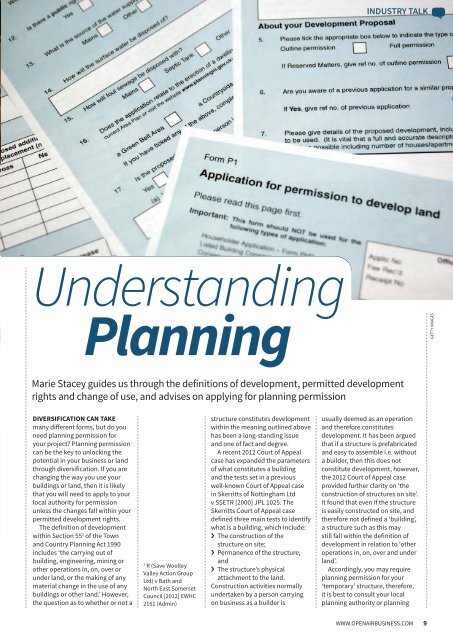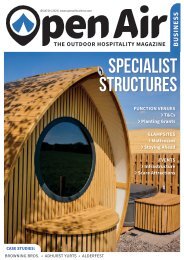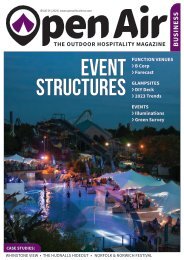Open Air Business February 2017
The UK's outdoor hospitality business magazine for function venues, glamping businesses and outdoor event organisers
The UK's outdoor hospitality business magazine for function venues, glamping businesses and outdoor event organisers
You also want an ePaper? Increase the reach of your titles
YUMPU automatically turns print PDFs into web optimized ePapers that Google loves.
INDUSTRY TALK<br />
Understanding<br />
Planning<br />
GETTY IMAGES<br />
Marie Stacey guides us through the definitions of development, permitted development<br />
rights and change of use, and advises on applying for planning permission<br />
DIVERSIFICATION CAN TAKE<br />
many different forms, but do you<br />
need planning permission for<br />
your project? Planning permission<br />
can be the key to unlocking the<br />
potential in your business or land<br />
through diversification. If you are<br />
changing the way you use your<br />
buildings or land, then it is likely<br />
that you will need to apply to your<br />
local authority for permission<br />
unless the changes fall within your<br />
permitted development rights.<br />
The definition of development<br />
within Section 55 1 of the Town<br />
and Country Planning Act 1990<br />
includes ‘the carrying out of<br />
building, engineering, mining or<br />
other operations in, on, over or<br />
under land, or the making of any<br />
material change in the use of any<br />
buildings or other land.’ However,<br />
the question as to whether or not a<br />
“WOODS ARE<br />
DESCRIBED AS<br />
HAVING A HIGH<br />
‘CARRYING<br />
CAPACITY’;<br />
THAT IS, THEY<br />
HAVE AN<br />
ABILITY TO<br />
ABSORB<br />
LOTS OF<br />
PEOPLE AND<br />
ACTIVITIES”<br />
1<br />
R (Save Woolley<br />
Valley Action Group<br />
Ltd) v Bath and<br />
North East Somerset<br />
Council [2012] EWHC<br />
2161 (Admin)<br />
structure constitutes development<br />
within the meaning outlined above<br />
has been a long-standing issue<br />
and one of fact and degree.<br />
A recent 2012 Court of Appeal<br />
case has expanded the parameters<br />
of what constitutes a building<br />
and the tests set in a previous<br />
well-known Court of Appeal case<br />
in Skerritts of Nottingham Ltd<br />
v SSETR [2000] JPL 1025. The<br />
Skerritts Court of Appeal case<br />
defined three main tests to identify<br />
what is a building, which include:<br />
› The construction of the<br />
structure on site;<br />
› Permanence of the structure;<br />
and<br />
› The structure’s physical<br />
attachment to the land.<br />
Construction activities normally<br />
undertaken by a person carrying<br />
on business as a builder is<br />
usually deemed as an operation<br />
and therefore constitutes<br />
development. It has been argued<br />
that if a structure is prefabricated<br />
and easy to assemble i.e. without<br />
a builder, then this does not<br />
constitute development, however,<br />
the 2012 Court of Appeal case<br />
provided further clarity on ‘the<br />
construction of structures on site’.<br />
It found that even if the structure<br />
is easily constructed on site, and<br />
therefore not defined a ‘building’,<br />
a structure such as this may<br />
still fall within the definition of<br />
development in relation to ‘other<br />
operations in, on, over and under<br />
land’.<br />
Accordingly, you may require<br />
planning permission for your<br />
‘temporary’ structure, therefore,<br />
it is best to consult your local<br />
planning authority or planning<br />
WWW.OPENAIRBUSINESS.COM 9 9


















